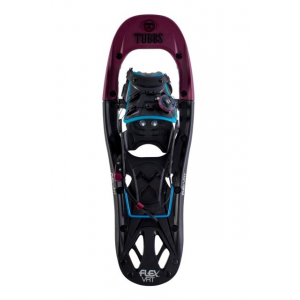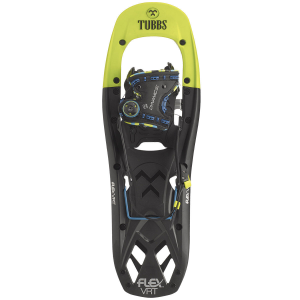
The Tubbs Flex VRT is a plastic decked snowshoe with an aggressive crampon setup that's ideal for snowshoeing in steep and mountainous terrain. It has an easy to use Boa binding system that clamps down around your boots and won't slip in use, along with a flip-up heel bar to reduce calf fatigue when climbing hills. The decking provides good flotation and flex, although the plastic can be a little noisy on hard crusty snow. Tubbs also makes a snowshoe call the Flex Alp, which is identical to the Flex VRT, with the exception of the Boa binding.
Specs at a Glance
- Gender: men's; a women's model is available in smaller sizes
- Weight: 4 lbs 8 oz in size 24″
- Type: Backcountry, including steep climbing
- Decking: Plastic
- Heel bar: Yes
- Binding: Boa wire lace w/rear buckle
- Crampon: Front crampon, toothed side bars, back deck crampon – all steel
- Sizes: 24″, 28″
Bindings
The Flex VRT has a Boa-style wire lace binding that clamps down on the front and sides of your boots, while a rear heel strap holds it in the binding. The Boa system consists of a wire and a knob that you twist to tension the wire. The wire loops through the tops and sides of the Flex VRT binding, so that when you tighten it, it clamps around your foot. If you pull up on the knob, the wire is released and goes slack so you can remove your foot. The nice thing about this Boa closure is that it doesn't pop open when you're snowshoeing.

The top of the Boa binding has a foam pad that presses down on the top of your boot, distributing the pressure over a wide surface area. This helps prevents the formation of hot spots on the tops of your toes, especially if you wear a lighter weight boot without a beefy toe kick or toe box. There is a strap at the back of the binding which prevents the back of your boot from sliding out of it. The buckle that Tubb's uses to secure the rear strap is non-intuitive, but works well if you simply pull on the end of the strap to lock it in place.

I haven't experienced any freeze up with the Boa system, although it's a concern in mixed conditions when you have to trudge through puddles, mud, slush, and snow. I always carry hot drinking water, so worst comes to worse, I can pour it over the Boa knob to defrost it. However, ice does form inside and around the rear binding buckle. This isn't a problem when removing the snowshoe, but ice chunks inside the buckle can prevent the internal pin from pushing through the holes in the strap. If the rear strap doesn't stay closed, open it up and make sure ice hasn't formed inside it. It's easy enough to break it off with your finger.
Having a snowshoe binding that stays closed and secure all day is huge benefit. Huge. The only downside of the VRT's Boa binding is its bulk, because it can make it more difficult to attach the sides of a backpack, where they're the most efficient to carry. If you do buy the VRT's, make sure your backpack's side compression straps are long enough that you can lash the snowshoes to the sides of your backpack.

Crampons
While the Boa binding is a slick feature that adds a lot of value to these snowshoes, the crampon system is where the rubber hits the road. The Flex VRT has a hinged crampon with six large crampon teeth that let you kick into slopes and climb steep hills. There are two long, toothed rails that run down the sides of the snowshoes, and a pair of shorter rails at the tail-end to keep you tracking straight. The Flex VRT's crampon setup is on par with the MSR Lightning Ascent and MSR Evo Ascent, the two most capable snowshoe climbers available, although configured slightly differently.

The hinged front crampon has crampon teeth that face backward and along the sides, in addition to forwards. This helps prevent backsliding on slopes or ice-covered ledge, while the side teeth prevent lateral sliding. The two side-rail crampons are curved, which provides a better grip on sheer ice, than the straight rails on the MSR Evo Ascent snowshoe. The side rails are quite long and run along the entire snowshoe. There's also a small third crampon at the rear of the decking. The "Flex" in this snowshoe's name refers to the fact that the rear decking flexes as you walk and this small rear binding helps prevent fishtailing so you're stride remains straight and true.
Net Net. The Flex VRT crampons are best in class.
Heel Bar
The Flex VRT has a heel bar that you can flip up when climbing hills or steep inclines. There's a small depression in the back of the decking that lets you get your finder under the bar to flip it up. The heel bar lifts up the rear of your boot under the heel (the feeling is like walking in high heels) relieving stress on your calves and reducing fatigue on inclines. Imagine you're hiking up a hill and your ankle is flexed so your toes point upwards. When the heel bar is deployed, your foot remains nearly flat, making it much easier to climb the incline. You almost have to experience it to understand what a huge difference it makes. When you reach level ground again, you flip the heel bar down and walk normally.

I consider a heel bar a must-have if you plan on climbing hills or mountain trails. They're completely revolutionized snowshoeing when they were introduced, but their usually not found on recreational snowshoes, just backcountry ones.
Flotation
The Flex VRT provides excellent flotation, in part because it's only available in 24″ and 28″ sizes. These are not the standard 22″, 25″, and 30″ inch sizes that most other snowshoe manufacturers sell. Being longer, they provide more surface area and therefore more flotation.
However they are noisy snowshoes since they're made with plastic decking. On the bright side, you'll never surprise a large animal or hunter when wearing these snowshoes. They'll hear you coming.

Recommendation
The Tubbs Flex VRT is a premium backcountry snowshoe with a Boa wire lace binding system that is easy to secure and will stay locked on to your boots for the duration of your trip. The durability of its plastic and steel construction, aggressive crampons, and heel bar make it suitable for climbing up steep inclines and in mountainous terrain. If you've ever been frustrated by the strap-based binding on MSR's Lightning Ascent Snowshoes or the MSR Evo Ascents, or its a concern, I'd recommend purchasing the Tubbs Flex VRT. While the VRT has a bulkier binding, it's definitely in the same class as those two best of breed snowshoes. Highly Recommended.
Compare 4 Prices
-

 CampSaver.com
CampSaver.com $259.95$207.96View -

 Amazon US
Amazon US $267.93$259.95View -

 Sunny Sports $259.95View
Sunny Sports $259.95View -

 Eastern Mountain Sports $259.95View
Eastern Mountain Sports $259.95View
Disclosure: Tubbs provided the author with snowshoes for this review.
Help support this site by making your next gear purchase through one of the links above. Click a link, buy what you need, and the seller will contribute a portion of the purchase price to support SectionHiker's unsponsored gear reviews, articles, and hiking guides.The post Tubbs Flex VRT Snowshoe Review appeared first on Section Hikers Backpacking Blog.
from Section Hikers Backpacking Blog https://ift.tt/2QSnere
No comments:
Post a Comment